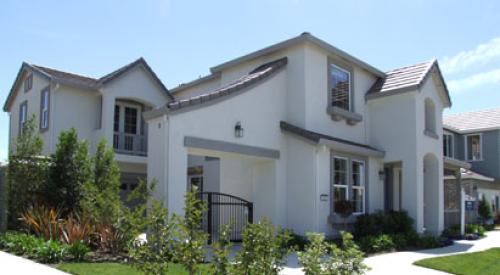The bad news: 2000 is probably the year.
The good news: It is not going to be that bad.
Virtually every home building analyst that Professional Builder asked late last year predicts a slowdown-one that actually began to appear in the fall. But the size of the slow down does vary slightly.
An optimistic estimate is one from the National Association of Home Builders’ chief economist David Seiders. He estimates that 1.54 million homes will be built this year, down from 1.66 million last year. On the lower end of the spectrum is David Lereah, chief economist with the Mortgage Bankers Association. He thinks 1.48 million starts are more likely. Though not quite on par with the record levels of home building activity recorded in 1998 and 1999, these figures provide plenty of reason to believe that most builders will not feel much of a difference this year.
From a regional standpoint there could be significant variations, says Sara L. Johnson with Standard & Poor’s DRI. She sees room for continued recovery in California in particular, but predicts that the Midwest and other parts of the West could be where the slowdown is "concentrated."
Another point of agreement among experts: There does appear to be a limited downside risk in the form of a potential stock market correction. Seiders and Lereah say they have already built somewhat of a stock market correction into their forecast for housing starts, but not a major correction of the variety that would sap the very high levels of consumer confidence that currently exist.
Because home ownership is at all time high levels in the United States, most home-buying activity is currently "discretionary," says Seiders. And some buyers would probably go away quickly in a strong bear market. Indeed, part of what would make a stock market correction so potent, even though it is relatively unlikely, is another important statistic. The savings rate in the United States is at an all-time low. People have been spending more as their stock market investments have grown and it keys much of the current wave of high consumer confidence.
All Part of the Plan
The economy and not the underlying demographics of the home building industry are at the heart of the slowdown the industry will be seeing next year, most analysts agree. Over the long term, very high immigration levels, the characteristics of Generation X, as well as those of a surging sector of active adults will take on a greater prominence in the single family construction market. Meanwhile, the economy’s slowdown has been entirely planned and engineered by the Federal Reserve Bank of the United States.
When the Fed raised rates last fall to return short term interest rates to a neutral level, it was expected that one or two additional rate hikes would follow early this year to keep the economy from over heating. And there are many positives to this scenario, Seiders says.
First of all, the input markets of construction labor and certain key materials, where supplies have been tight, will have a chance to come into balance. And secondly, a deliberate slow down now will likely "pave the way for at least a couple years of good activity to follow," says Seiders. "The Fed’s objective is to take some steam out of the economy, including the housing sector, with the idea of keeping this aging expansion going longer."
There was a time 20 years ago when rate hikes of the sort being talked about would be cause for general alarm among home builders, but a revolution in the mortgage markets has changed all of that, says Goldman Sachs analyst Nathan Judge. Where once a 100 basis point change in 10 year bonds-say, from 5.25% to 6.25%-would have meant a 50% variation in mortgage interest rates, says Judge, it now would only account for a 15% change in mortgage rates.
The reduced volatility in mortgage interest rates is a great benefit to today’s builders and stems from the increasing sophistication of lending instruments within the once non-existent secondary mortgage market. From 6-month adjustable mortgages to a 15-year fixed rate with a balloon payment at the end, hundreds of new products fit the needs of more buyers than ever. That said, a consensus estimate among home building analysts has rates for 30-year fixed mortgages at 8.0% in spite of the expected hike by the Federal Reserve.
These only moderately higher mortgage rates will not significantly dampen home buying demand, and, likewise, prices for new homes of all types will likely continue their steady rise of recent years, says the NAHB’s David Seiders. Over the last two years, he says, prices nationally have risen at a 6% annual rate. This year prices will again rise, but at a more moderate 4% to 5%, he says.
Important Demographics
Many experts rightly argue that demographic data cannot radically affect the market for new homes on a year-over-year basis, but some important population trends will begin to have a greater impact in the year 2000. A recent industry roundtable sponsored by the NAHB Research Center and Professional Builder explored this topic.
Research Center analyst Deborah Adler explained the implications of immigration for the housing industry. About a decade ago, the country began a period of massive growth in the number of immigrants. About 11 million people entered the country during the 1990s and the rate of one million new immigrants per year is not expected to vary any time soon. There are several significant reasons to pay attention to this important trend, according to Adler.
- Immigrants represented about one third of the population growth during the 1990s and will thus continue to represent a comparable ratio of new-home buyers.
- Immigrant populations form households at generally the same high rate as whites. About 70% eventually form households.
- Education and income levels among immigrants tend to be higher than average, with important ramifications for the single-family market.
Among domestically born Americans, there are several important groups to consider in 2000, reported the NAHB Research Center’s Christine Thompson Barbour, director of HOMEBASE services. Generation X, those born between 1965 and 1977 are smaller in number and are forming households later in life than their predecessors, the Baby Boomers. Gen Xers are now well known to home builders for these traits. And, generally builders have rightly refocused their efforts on Baby Boomers as they continually add to the ranks of Empty Nesters and Active Adults.
Following the Gen Xers is group that many are identifying as Echo Boomers. These are the children of Baby Boomers born since 1977. Numbering 84 million, they will become a significant demographic factor in home building several years from now, but this group is already adding about 20,000 entrants to households headed by 18-to-24 year-olds each year.
"Some people have said that there will be a major demographic weakening for single family housing and major persistent house price erosion," says Seiders. "That is pretty crazy stuff we think. Frankly the demographics look pretty darn good for this industry."
Beyond demographics and economics and the limited chances for a stock market debacle, the housing market looks good, most experts agree. But home buying has always been cyclical, so many investors in home building companies believe that the current high plateau cannot last. There is mentality of always waiting for the other shoe to drop among this group, evidenced by the very low price to earnings ratios for home building stocks currently.
Perhaps the strongest indicator of health is backlog, says Timothy L. Jones, managing director for Ryan Beck & Co’s Southeast Research Group. At the beginning of 1999, backlogs for the industry’s largest home builders were at record levels. Going into 2000, they were expected to be down slightly but still very high, he says. Some of the larger firms even grew their backlogs versus 1998. Kaufman & Broad, for example, bettered its backlog figure by 26% with 8,785 units on order as of Nov. 30, 1999, versus 6,946 the year before.
Says Jones, "Most of these companies already have the first part of the year in the bag."
Also See:
NAHB Housing Forecast (1997-2001)












